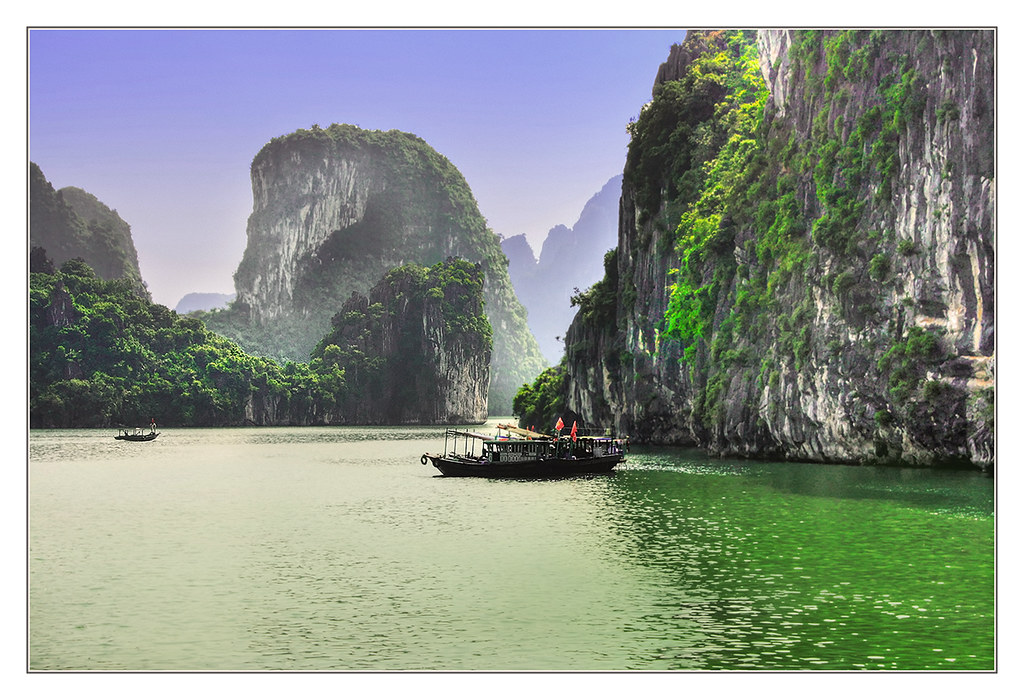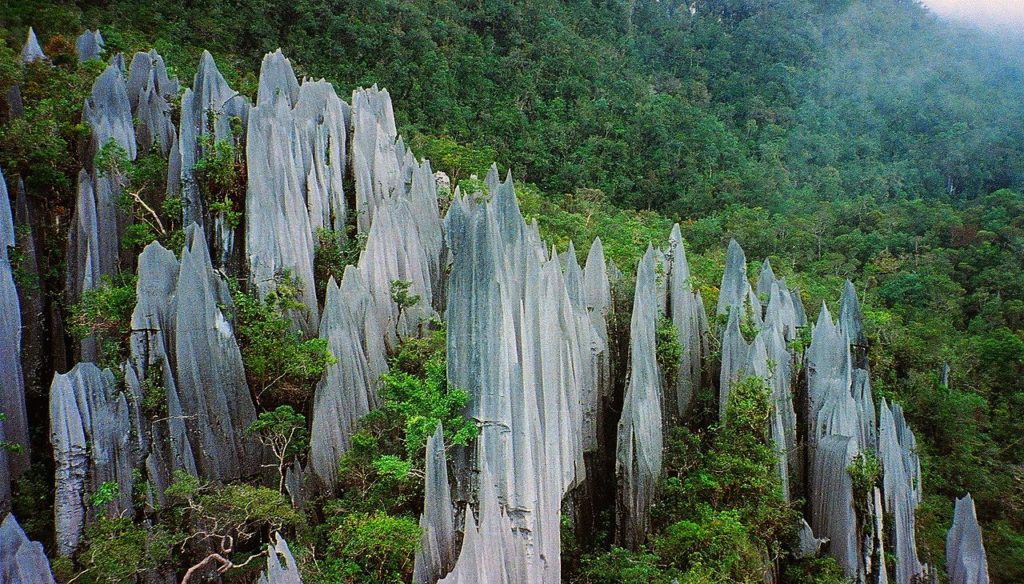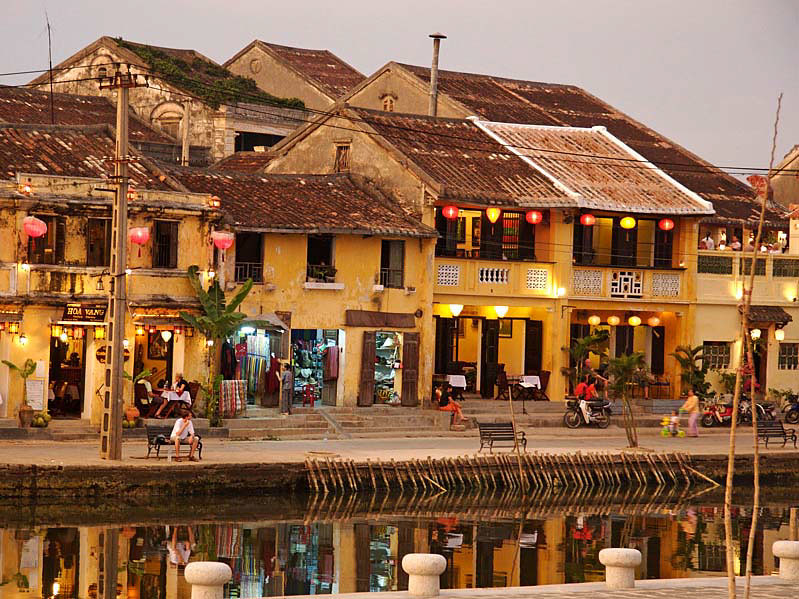1. Halong Bay, Cat Ba Island, Vietnam
Lying prostrate aboard an old wooden junker, peering out across the emerald waters as jungle-covered precipices rear out of nowhere isn’t the only way to experience Cat Ba Island’s Halong Bay – it remains among the best, though.
These limestone karst pillars aren’t unique to Vietnam, but nowhere on Earth is their scale so dramatic, sprouting some 1,600 spines from the waters of the Gulf of Tonkin, birthing towering islands and islets out of bounds to all but the native seabirds that have made them home.
 The site was first inscribed by UNESCO in 1994. Twenty-something years later, little has changed except how to see them and the increasing numbers of those who have. The slow-screw of erosion has notched hidden caves and dramatic arches into many of its rises.
The site was first inscribed by UNESCO in 1994. Twenty-something years later, little has changed except how to see them and the increasing numbers of those who have. The slow-screw of erosion has notched hidden caves and dramatic arches into many of its rises.
Kayak out for a more intimate look at the likes of Thien Cung, famed for its impressive stalagmites and stalactites; or drift past oysters farms and floating villages – ramshackle constructions linked by trembling walkways – to seek out secret beaches away from the boat-going hordes.
2. Singapore Botanic Gardens, Singapore
Despite its reputation as a ‘Garden City’, urban Singapore isn’t the first place that springs to mind when you think rare flora. Which makes swapping its hotbox streets and hawker malls for the cool, bucolic quiet of its 157-year-old Singapore Botanic Gardens one of the city’s great pleasures.
 Inscribed in 2015, it was just the third botanic garden to be listed by UNESCO (after Kew and Italy’s Padua). The site also has roots deep in Singapore’s colonial past, and once nurtured the seeds that would go on to form the great 19th-century rubber plantations of Malaysia, shaping whole swathes of South-East Asia. These days, though, it’s the early-rising, free-to-enter green lung of the city.
Inscribed in 2015, it was just the third botanic garden to be listed by UNESCO (after Kew and Italy’s Padua). The site also has roots deep in Singapore’s colonial past, and once nurtured the seeds that would go on to form the great 19th-century rubber plantations of Malaysia, shaping whole swathes of South-East Asia. These days, though, it’s the early-rising, free-to-enter green lung of the city.
Perambulate the grounds north to south, passing red-faced joggers and limber tai chi students, and cover two and a half kilometres of primary rainforest and parkland. Spot sea eagles, waders and Malayan giant frogs, then strain up the hill to the National Orchid Garden: a sweeping enclosure containing some 60,000 plants. Keep your nostrils primed for its Papilionanda ‘Mimi Palmer’ orchid – it smells a bit like chocolate.
3. Luang Prabang, Laos
Pitched snug in a valley at the confluence of the Nam Khan and Mekong rivers and enfolded by lush mountains, Laos’ UNESCO-listed city of Luang Prabang has a setting to melt any cynic.
It was once the country’s capital, long before its monarchy drifted into obsolescence and was forced to accept French protection in the late 19th century. The legacy of that deal is the crumbling colonial architecture that plugs the gaps between red-and-gold-roofed temples and lends the city much of its fin-de-siècle charm.
 This fusion of cultures is everywhere, from the mingling of fresh coffee and frangipani in the morning air to the sight of saffron-robed monks floating past faded European-style facades. The pace of life rarely rises above gentle, taking its cue from the slow boats that drift into port.
This fusion of cultures is everywhere, from the mingling of fresh coffee and frangipani in the morning air to the sight of saffron-robed monks floating past faded European-style facades. The pace of life rarely rises above gentle, taking its cue from the slow boats that drift into port.
Follow their lead and meander through the colourful morning market before taking a ride out to the turquoise-blue cascades and pools of Tad Se, or drifting downriver to the Pak Ou Buddha Caves. Finish atop Phou Si (Sacred Hill) at sunset, gazing up at the burnt orange sky reflected in the golden stupa at its summit.
4. Gunung Mulu National Park, Borneo, Malaysia
There isn’t exactly a shortage of national parks on Borneo, but the 528 sq km of old-growth rainforest trails, bottomless caverns and towering karst peaks that scatter Gunung Mulu makes this South-East Asia’s most diverse.
 UNESCO recognised the park in 2000, citing its incredible wildlife and landscape. The two combine in a gruelling hike up namesake Mount Mulu (2,376m) – a route first discovered by a Berawan tribe rhino-hunter in the 1920s. Spot playful gibbons and far less extrovert sun bears before clouds smother your vision. To the northwest lies Mount Api (1,170m), the largest piece of limestone in the Far East. From the ground, its shard-like pinnacles of karst strike out at the heavens, taking three days to trek.
UNESCO recognised the park in 2000, citing its incredible wildlife and landscape. The two combine in a gruelling hike up namesake Mount Mulu (2,376m) – a route first discovered by a Berawan tribe rhino-hunter in the 1920s. Spot playful gibbons and far less extrovert sun bears before clouds smother your vision. To the northwest lies Mount Api (1,170m), the largest piece of limestone in the Far East. From the ground, its shard-like pinnacles of karst strike out at the heavens, taking three days to trek.
But the park’s show-stealer is its 295km of surveyed caves. You can smell Deer Cave long before you complete the 3km trek to its mouth, but it’s worth a few nostrils of guano to stand in its main chamber – large enough to fit St Paul’s Cathedral. Stay late to see its population of 3 million bats pour out at sunset, spreading like black ink across a blotting-paper sky.
5. Sukhothai and Associated Historic Towns, Thailand
As the capital of the original Kingdom of Siam, it was Sukhothai that kickstarted Thailand’s Golden Age 750 years ago, when Theravada Buddhism first swept the land. It shone just a few centuries, though, before the rival Kingdom of Ayutthaya chipped away its power; jungle claimed the rest.
Today, the far less influential New Sukhothai greets visitors, acting as a base to explore the 70 sq km of its Old City (Sukhothai Historic Park). Bicycle is the best way to get around – pedal over to largest-surviving temple Wat Mahathat; the long-eared, thin-faced Buddha at its centre is typical of the era.

Elsewhere, Wat Sra Si is still partly inhabited by monks and every November its lake fills with thousands of floating candles as part of Loy Krathong. Watch their pinprick lights glimmer across the inky-black water and bid farewell to your worries.
Outside of the walled city, you will need a taxi to visit the nearby ruins of Kamphaeng Phet, formerly a military outpost, and Si Satchanalai, the centre of the old kingdom’s prodigious ceramics industry. Neither can match the Old City for grandeur, but tend to be a lot more peaceful.
6. Pyu Ancient Cities, Myanmar
In 1996, Myanmar nominated eight sites for UNESCO inscription, and for nearly two decades struck out. Bagan is a prime example: popular with visitors, but accusations of temples being rebuilt dogged its reputation.
Today, the political landscape is very different. UNESCO is now working in-country to help preserve sites like Bagan, and in 2014 the partly excavated cities of the ancient Pyu people became the first area of Myanmar to achieve World Heritage status.
 Having said that, it’s not the most glamorous. Few visitors would swap cruising Myanmar’s Lake Inle for traipsing the dusty, rural Irrawaddy Basin. All of which is a shame because the ancient cities of Halin, Beikthano and Sri Ksetra contain some of the earliest surviving examples of Buddhism in South-East Asia, and tracking down brickwork stupas poking out from the scrub can be a thrill.
Having said that, it’s not the most glamorous. Few visitors would swap cruising Myanmar’s Lake Inle for traipsing the dusty, rural Irrawaddy Basin. All of which is a shame because the ancient cities of Halin, Beikthano and Sri Ksetra contain some of the earliest surviving examples of Buddhism in South-East Asia, and tracking down brickwork stupas poking out from the scrub can be a thrill.
The city of Halin (said to have influenced the ancient Siamese capital of Sukhothai) is the most accessible site. Parts of its original city wall have been uncovered, as have plenty of graves with their unearthed weapons and ornaments on display. You will need a knowledgeable guide (with wheels), though, if you’re to come away with more than just ‘ruin shots’.
7. Hoi An, Vietnam
Far removed from the fogs of exhaust that envelop many a visit to South-East Asia, UNESCO-listed Hoi An is a quiet, sculpted riposte to the pace of modern Vietnamese life.
It wasn’t always the case, though. The city was once a thriving port town and home to merchants from across Asia until the Thu Bon River silted up some 200 years ago and the traders moved on elsewhere.
 Reminders of Hoi An’s multi-cultural past abound in its French-style buildings, Chinese Quarter and dainty Japanese-style covered bridge. The Chinese influence is particularly visible in the city’s assembly halls, each built according to the home province of its settlers.
Reminders of Hoi An’s multi-cultural past abound in its French-style buildings, Chinese Quarter and dainty Japanese-style covered bridge. The Chinese influence is particularly visible in the city’s assembly halls, each built according to the home province of its settlers.
Wander their cool interiors before spilling out onto Tran Phu, the city’s oldest commercial street. Lined with traditional wooden-fronted stores, during the monthly Full Moon Festival the glow of lanterns bathes their frontages a hazy, atmospheric red.
Traffic is banned from the centre, affording the chance to gaze undisturbed at the faded pastel facades, collonaded balconies, cafés, markets, tailors and boutiques that cluster the Old Town. All is peace, but for the ringing of temple bells and the clatter of visitors’ feet. It’s hardly a hidden escape, but it’s no wonder Hoi An scooped ‘Best City’ at this year’s Wanderlust Readers’ Travel Awards.
According to wanderlust.co.uk













